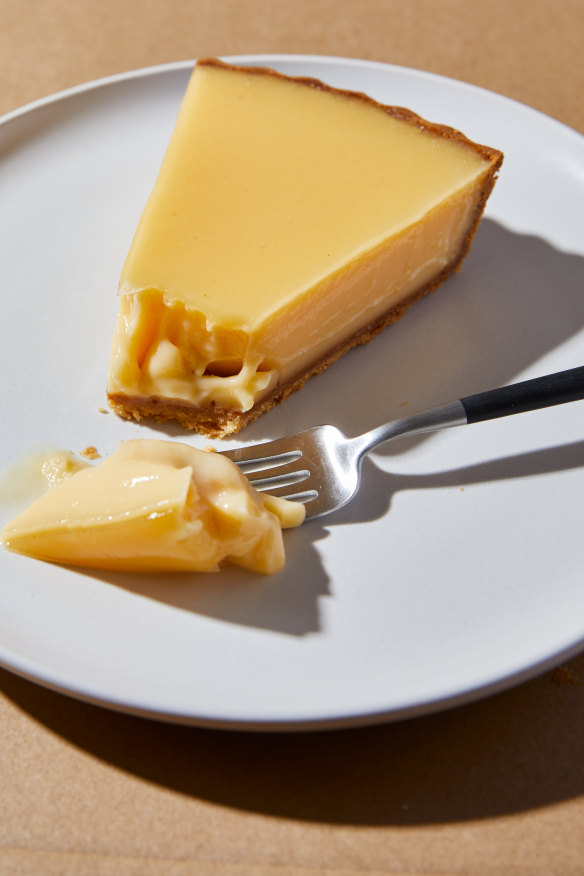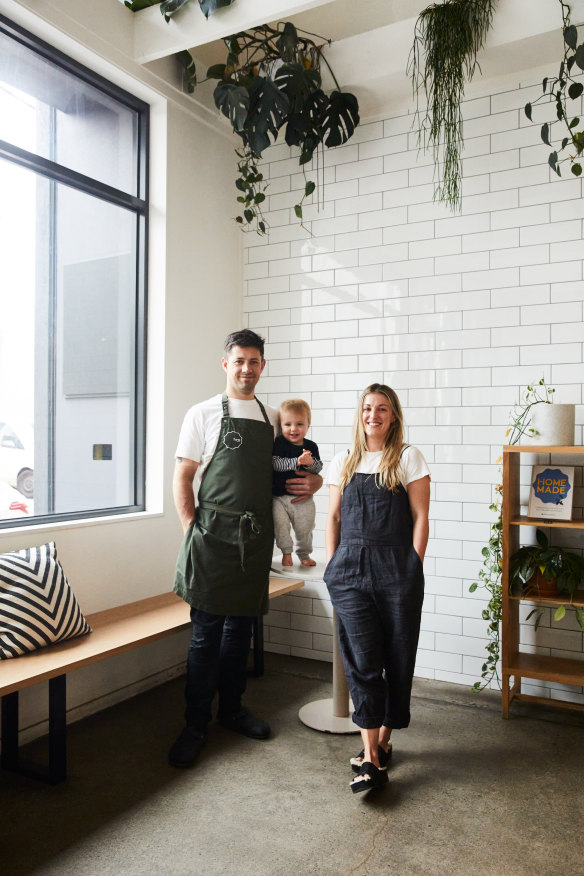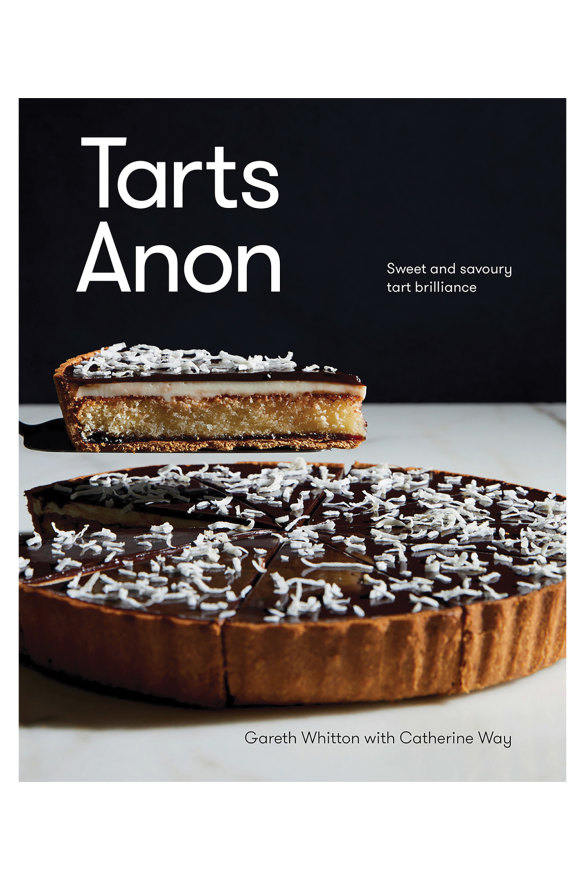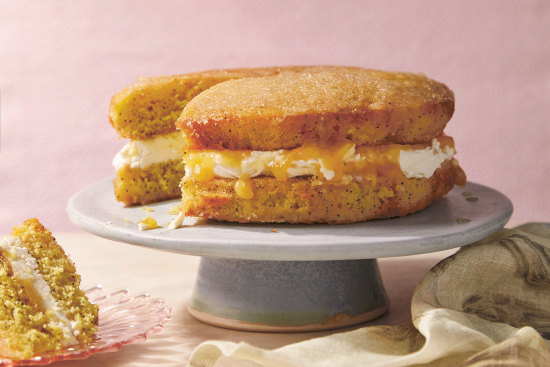How to make this elegant lemon tart from cult Melbourne pastry shop Tarts Anon
This fragrant, zingy dessert is the perfect balance of creamy sweetness and sour refreshment. Gareth Whitton and Catherine Way of lockdown sensation Tarts Anon share the secret to making it.

Plain old lemon tart
One of the first tarts we had on the Tarts Anon menu was the lemon and rhubarb tart (see the variation below). It was insanely popular, but people still asked for a plain lemon tart. “No way,” we always said, because we genuinely believed the lemon and rhubarb was superior. One day we relented and decided to have a go at what Cat called the “plain old lemon tart”, named as a bit of a jab. Lo and behold, the result reminded us how great a simple, well-executed lemon tart truly is, so we admitted defeat and now it’s one of the staples on the menu. Be warned, though, while the method and ingredient lists are short, this is the tart that causes the most stress among our kitchen staff, Gareth included. It’s temperamental, fragile, and a little difficult to work with. But it’s also fragrant, zingy and the perfect balance of creamy sweetness and sour refreshment.
INGREDIENTS
- 185g lemon juice
- 10g lemon zest
- 130g pouring cream
- 150g double cream
- 250g caster sugar
- 95g egg
- 220g egg yolk
- 70g dulce de leche (see below)
- 1 × baked shortcrust pastry shell (see below)
METHOD
- Preheat the oven to 125C fan-forced (145C conventional).
- Add the lemon juice and zest, creams and sugar to a saucepan over medium heat. Bring to a simmer then immediately remove from heat. To temper the whole eggs and egg yolks, add them to a mixing bowl and whisk in a small amount of the hot cream mixture until well incorporated. Then add the remaining cream mixture and whisk again until combined. Using a hand-held blender, blend until the mixture is shiny and smooth, keeping the head of the blender submerged so that no air gets into the mix. Strain the custard into a jug and let sit for 10 minutes for any impurities to rise to the top, then skim them off with a ladle.
- In the meantime, spread the dulce de leche over the base of the baked pastry shell. This will provide a protective layer between the custard mix and the shell, ensuring it stays crisp. Once the surface is clear of bubbles, place the prepared shell in the oven. Pour the warm custard into the tart shell straight away to ensure that the mixture cooks evenly in the oven.
- Bake for 30 minutes, or until the custard is slightly wobbly in the centre, then remove from the oven and allow to cool.
- Once the custard has completely cooled, remove the tart from the tin and portion into slices with a hot, sharp knife.

Dulce de leche
- Take any number of 400g cans of condensed milk and remove the labels. This will make the clean-up that much easier.
- Place the cans lid side up inside a saucepan that will allow you to have at least 2cm of water above the tops of the cans, but not be in danger of overflowing when the pot boils – roughly another 2cm.
- Pour hot water into this pot – the hotter the better. This won’t affect how the caramel cooks, but the timer starts once the water comes up to temperature, so this just gets you there quicker.
- Place the pot onto the stove and bring to a boil, then reduce to a simmer and set a timer for six hours. Keep an eye on the water level and top it up with hot water as you go so that the cans stay under water at all times. The water provides a protective barrier (as it cannot go above 100C, give or take). Let the water run out, and the milk inside the can will burn on the base as well as expand and explode in some cases. Although the liquid condensed milk is contained inside a can, the parts of the caramel that aren’t submerged remain lighter than the parts that are, especially once the proteins start to set and the milk becomes solid.
- Once the time is up, remove the cans from the water and allow them to cool before opening – trust us. The pressure built up inside the can over time can cause the contents to spit out while still hot and it’s not a pleasant experience. You can also leave these cans inside the water until it can be safely removed once the water cools. This may take up to half an hour depending on the number of cans you’ve chosen to cook, but the extra bit of time won’t change how the caramel comes out.
Shortcrust pastry (Pâte brisée)
INGREDIENTS
- 200g plain flour
- 100g cold unsalted butter, cut into cubes
- 3g salt
- 50g water
METHOD
- Place the butter, flour and salt into a bowl (this process can also be done in a kitchen stand mixer or food processor). Using your fingers, work the ingredients together until they resemble fine bread crumbs and no lumps of butter are present.
- Add the water a little at a time (or in a steady stream if using a kitchen stand mixer), until it forms a firm but malleable mixture. If you used a food processor earlier, it’d be best to finish this one off by hand.
- Move the dough to your benchtop and work into a puck-sized shape. Wrap with plastic wrap and allow to rest in the fridge for at least 30 minutes.
- Preheat your oven to 180C fan-forced (200C conventional). Place the pastry on a piece of baking paper and cover with a second piece of baking paper. Using a rolling pin, roll out the pastry into a circle roughly 35cm wide, and about 3mm thick. Allow the pastry to firm up again in the fridge for at least an hour before lining the tin (if lining the tin immediately, be sure to rest it for at least an hour).
- Remove one piece of baking paper from the pastry and drape the pastry over your tart tin. You may find this easier to do by using a rolling pin.
- Press the pastry into the knuckles of the tart tin using the flats of your fingers.
- Use a sharp knife to remove any excess trim from the edges of the pastry. Allow the pastry to sit for 15 minutes or so in the freezer for one final rest.
- Take one large sheet of aluminium foil and gently press into the edges of the pastry shell, ensuring that the sheet is big enough to go over the edge and completely line the tart. Fill it to the brim with uncooked rice, then fold the foil gently back over the top and place into the oven.
- Bake for 25-30 minutes, or until the edges of the pastry are a nice medium-golden colour. Remove from the oven and sneak a look under the foil to check the doneness. Cook until the colour is consistent, then allow to cool at room temperature. Remove the foil and rice when cool enough to touch.
Makes 1 tart shell
Lemon and rhubarb tart variation
- Spread a layer of rhubarb compote (see below) over the base of the pastry shell before pouring the custard on top.
Rhubarb compote and syrup
INGREDIENTS
- 150g rhubarb
- 180g caster sugar
- 120g water
METHOD
- In a saucepan, bring the rhubarb, sugar and water to the boil, then remove from heat. Once the rhubarb is soft, strain through a sieve and reserve the syrup for the glaze. Set 50g of the rhubarb aside for the gel and spread the remaining rhubarb on a paper-lined tray and place in the oven for about 15 minutes. Once the fruit has dried out slightly into a nice stiff compote, spread 100g over the base of the shell.

This is an edited extract from Tarts Anon by Gareth Whitton and Catherine Way, published by Hardie Grant Books, RRP $45. Photography: Armelle Habib
Continue this series
Here are recipes from 30+ of the best cookbooks of 2024Up next

This lovely layered lemon cake combines two favourite citrus recipes in one
Lemon and poppy seed cake meets lemon drizzle in this gorgeous bake from food writer Eleanor Ford.

The recipe that proves that, yes, barley actually can be delicious
Plus three other travel-friendly recipes, including rustic goat’s cheese tarts, a crunchy broccoli ‘spoon’ salad and an easy strawberry jam slice.
Previous

Making chilli biang biang noodles at home is easier than you may think (and they’re vegan too)
These meat-free Chinese belt noodles from Shaanxi province have won fans all over the world for their chewy, dense texture and chilli-flecked sauce.
The best recipes from Australia's leading chefs straight to your inbox.
Sign up